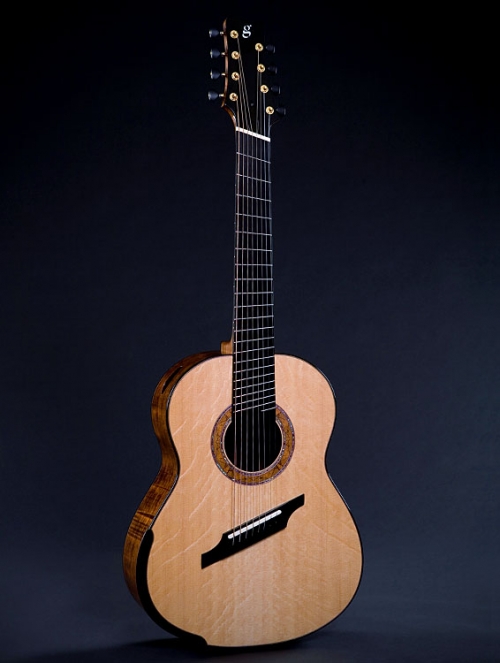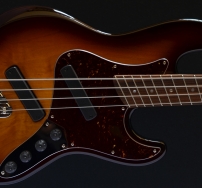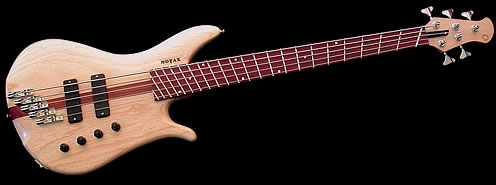Муздеталь
Музыкальные инструменты для начинающих и продолжающих
- Темы без ответов
- Активные темы
- Поиск
- Пользователи
- Наша команда
Соединить с аккаунтом в социальной сети
мультимензурные гитары с веерным расположением ладов
мультимензурные гитары с веерным расположением ладов
Сообщение ok1986jen » Пн май 06, 2013 1:13 pm
Хочется просто получить больше информации о таких инструментах, очень интересно. Именно об АКУСТИЧЕСКИХ гитарах такого типа, по тому как об электрогитарах и басах информация в рунете есть.
что это даёт? — ну сразу хочется сразу сказать, что это актуально для гитар с сильно пониженным строем, например баритонов или 7 и 8 струнных инструментов, где добавленные струны используются для расширения динамического диапазона вниз. Потому что при увеличении калибра струн их становится трудно заставить точно интонировать появляются проблемы с различной натяжкой высоких и низких струн. Вот от этих проблем позволяет уйти данная система — можно ставить более тонкие низкие струны т.к их мензура больше.
Жду дополнений и коментариев.
Да и ещё меня лично интересуют мультимензурные гитары акустические 7-струнные. Был ли у ваших мастеров опыт в изготовлении подобных инструментов т.к. я подумываю о заказе подобного (серийные найти невозможно).
Задаю этот вопрос на вашем форуме, потому как мне показало здесь присутствуют компетентные люди разбирающиеся в физике процессов звука, на других ресурсах подобные темы обычно заканчиваются поливанием грязью подобных нововведений от людей которые не только не держали в руках подобные инструменты, но даже не желают понять для чего это нужно))
— это не в коем случае не рекама, а информация.
P.S. может быть ваш магазин станет первым России, кто станет делать подобные предложения))
Сообщение Mmnt » Вт май 07, 2013 5:21 pm
Кроме Novax, такие гитары много кто делает, включая мастера Андрея Уайта:
http://andrewwhiteguitars.com/images/mo . etgallery/
Наш магазин готов делать любые предложения — при наличии желающих эти предложения оплатить. Пока мы наблюдаем строго обратный процесс.
Сообщение ok1986jen » Вт май 07, 2013 11:11 pm
А может подскажите мастеров, кто делает такие гитары в России.
Я всерьёз подумываю о таком инструменте, только вот платить даже 1000 долларов за то, что не держал в руках нет желания, хочется попробовать хотя бы бюджетный вариант, а их нигде нет. Может быть поэтому и спроса на них нет.
Сообщение Mmnt » Вт май 07, 2013 11:50 pm
«Бюджетный вариант» такой гитары не существует. Отдельный вопрос — насколько вообще такое надо, миллионы гитаристов обходятся обычными ладами, и иногда очень даже неплохо играют. Сеговия например или Иван Смирнов.
Вы написали уже много букв, однако так и не указали — в каком городе или хотя бы на каком континенте живете. Мы не знаем, что посоветовать гитаристу из Австралии или Суринама.
Сообщение Чекалов » Ср май 08, 2013 3:06 pm
Сообщение ok1986jen » Сб май 11, 2013 8:18 am
Mmnt — что-то для модератора вы слишком субъективны), если вам не интересно — не пишите мне,что мне это не нужно.
Когда-то и электрогитара была для всех таким «извращением» и все обходились без неё. Сейчас эта идея новая и разумеется ещё не прижилась, может и никогда не приживётся, но это покажет время.
Может Смирнов и не использует, а вот МакЛафлин попробовал.
Не надо Австралию, я конкретно спросил про Россию, если что — я из Тольятти.
а теперь по теме):
суть вот в чём. Чем толще струна, тем бОльшая у неё мензура в идеале должна быть для правильного и более точного интонирования. Посмотрев на бридж обычной хорошо отмензуренной 6-ти струнной электрогитары несложно заметить, что самую короткую мензуру имеет 1-струна, а самую большую 6-ая! Для шестиструнки такой разброс ещё не так критичен, а вот для 7-ми и уж тем более восьми более чем, т.к. в идеале 12 лад должен делить струну пополам. Поэтому если мензурить, например, 8-ую струну, настроенную в Фа-Диез на мензуре 25,5, то расстояние между порожком и 12-ым ладом будет ощутимо меньше, нежели от 12-го лада до кобылки на бридже. Соответственно, ни о каком отличном интонировании и речи быть не может, обычно уже после 8-го лада слышен нестроевич. Потому и начали выпускать, многострунные басы, семи- и восьмиструнки с веерными ладами. Также увеличение мензуры басовых струн позволяет использовать более тонкие струны, т.к. при увеличении мензуры струны имеют более сильное натяжение при настройке в нужную ноту, нежели бы они натягивались при стандартной мензуре в эту же ноту. Соответственно, если бы для Фа-Диеза при мензуре 25,5 понадобилась бы струна толщиной 80-85 для нормального натяжения, то на мензуре, например, 28 уже понадобится примерно 72-78.
Источник
Переменная мензура, Веерные лады, Мультимензура
Не хочешь смотреть рекламу? Зарегистрируйся!
Преимущества переменной мензуры:
Для разной высоты звука между открытыми струнами используется не только различное натяжение и различная толщина струн, но и различные длины колеблющейся части струн. Это в свою очередь позволяет сделать натяжение всех струн более равномерным и использовать менее толстые басовые струны по сравнению с обычными инструментами (разумеется, сравнения справедливы для одинакового строя).
При использовании менее толстых басовых струн на переменной мензуре требуется не такая сильная компенсация строя, а, следовательно, инструмент имеет лучшую тональную точность (лучше строит).
Басовые струны гитар с переменной мензурой звучат мощнее, имеют лучший резонанс, а тонкие дают более полный и яркий звук без тванга (гнусавости), нежели у обычных инструментов. 
Физика на стороне переменной мензуры, НО:
В действительности, различия в натяжении и калибре по всем шести струнам обычной гитары в стандартной настройке не достаточно существенны и не сделают преимущества веерных ладов очевидными.
Где эта конструкция действительно великолепна, так это на инструментах с увеличенным диапазоном: гитарах с семью струнами или более, бас гитарах от пяти струн или более, при использовании альтернативных строев с расширенным диапазоном, в том числе для баритон гитар.
При написании использовались метериалы stringboxanthropology.wordpress.com
Не хочешь смотреть рекламу? Зарегистрируйся!
Источник
What Are Fanned Frets? We’ll Show You!
What are fanned frets (or multiscale guitars), and what are the benefits?
Ever seen a guitar with frets that appear to be slanted? Have you asked someone exactly what those slanty frets are to have them reply, “They’re fanned frets you fool!” So, what are fanned frets?
A fanned fret guitar or multi-scale is where each string has a different scale length. For anyone that doesn’t know the scale length is the length of a string from the nut to the bridge. This is achieved by having the bridge and nut at an angle and then angling or fanning the frets to keep proper intonation across the board. This way you can have a short/regular scale on the highest string which gradually increases to a longer/baritone scale on the lowest string. For example a 25.5″ – 27″ guitar is a 1.5 inch fan. Each string gets .25 inches longer as it goes up to the lowest.
A multiscale provides multiple benefits to playability and tone when compared to regular straight scaled instruments. So first thing to look at are the pros and cons of shorter and longer scales when compared to each other. For example here is a comparison of a 25.5″ against a 27″ and visa versa.
Pros of the shorter scale:
- Less string tension
- Smoother sound especially on high strings
- More comfortable to play lead guitar
- Bends are easier(when using low tension strings)
- Easier to do long stretches
Cons of the shorter scale:
- Thick strings needed for tuning down
- Low end can be muddy/bassy/unclear
- Some people feel cramped when playing on the higher frets(Personal preference)
- Intonating when down tuning can be impossible if the saddle is as far back as it does
Pros of the longer scale:
- Clearer & tighter sound on low strings
- Better intonation across the board on low strings
- More string tension so lower gauges can be used
- More room when playing on the higher frets(Personal preference)
Cons of the longer scale:
- High strings can have too much tension
- Bends are harder(depending on scale length and string gauge)
- High strings can be very bright/harsh
- Stretching can be difficult, especially on the first few frets
Pros of a multiscale guitar that combines 25.5″ and 27″:
- Less string tension on higher strings so its easier to bend
- More string tension on lower strings so you can use a lower gauge string
- Smoother sound on higher strings
- Clearer/tighter sound on lower strings
- Better intonation on lower strings
- Lead playing is more comfortable on the higher strings(Personal preference)
- More room on the lower strings for rhythm work(Personal preference)
- Most string gauges like 9-42 for example work better on a multiscale guitar because of the progressive increase in tension so they are more balanced
- Less cutting out bass to tighten the low end and which can make the rest of the strings sound thin or bright
- Less cutting out the highs to make the higher strings smooth which can make the low strings lose definition.
So as you can see a multiscale guitar combines nearly all the pros of both the shorter and longer scale. With long and short straight scale instruments you often have to compromise the sound of the high and low strings when your are dialing in rhythm & lead tones, but with a multiscale the low strings are already tight and clear while the high strings are smooth giving you much more to work with.
What are the cons of a multiscale guitar?
- You need to like playing on longer scale lengths (personal preference)
- A really large fan can be uncomfortable (personal preference)
- Some chord shapes can be difficult
- Limited pickup options available but the market is getting better every year
- Limited production options available but again this is getting better every year
- If you want a specific fan thats not available from production companies then you will have to go custom
One of the big benefits of having a longer scale length for the lower strings is the increase in string tension compared to shorter scales.
Here is what a D’addario 9-56 string set looks like on a 25.5″ guitar:

Notice the drop in tension on the high B, low E and low B strings. For a lot of people this isn’t a problem but if you find the low B is going out of tune when you pick it too hard then you will need to up your string gauge. For the low B you would need to use a 59 gauge instead of a 56. However a 59 gauge will have slightly more bass and less definition than the 56. While there isn’t much of a difference with B tuning you will notice a drop in definition when tuning down to A or G because you will start using 60 – 70+ gauge strings. When you start using really thick strings on shorter scales there is a noticeable drop in tone, sustain and clarity. Also you can run out of room when intonating the bridge saddles back when down tuning on shorter scale guitars.
Here is what a D’addario 9-56 string set looks like on a 25.5″ and 27″ multi scale:
You can see that the tension is much more even on the wound strings. By going up 1.5 inches on the lowest string it ads nearly 2lbs of tension so if you used a 59 gauge on a 25.5″ you could then drop to a 56″ on a 27″. The highs strings haven’t changed much so you won’t notice much difference bending on the second and third plain strings.
So these are all the main benefits of a multiscale instrument. I am a huge supporter of the concept and in my opinion it is the future of the electric guitar. It solved so many of the problems and brick walls I’ve encountered when wanting a clear sounding low end for rhythm playing and warm sounding high strings for lead playing.
“Is it hard to get used to?”
Its very easy to get used to in my opinion. I find multiscale guitars very comfortable for playing lead and rhythm. This is personal preference so the only way for you to find out is trying one. If you are used to a 25.5″ guitar than you will have to stretch your fingers slightly more when playing on the longer lower scales.
“Are bar chords harder?”
Yes and no. Most people don’t notice much of a difference but certain chords can be difficult because of the direction of the fan.
“Is bending/vibrato hard?”
No, there is no real difference, you may have to bend a little higher compared to a straight scale guitar.
“What string gauges do I need?”
String gauges are personal preference but try dropping down a gauge on the low strings if you’re coming from a shorter scale guitar. If you’re coming from a longer scale guitar then try dropping the gauges on the plain strings.
“I tune to X tuning do I need a multiscale”
If you hear a noticeable drop in clarity when down tuning or you find you are compromising your tone to make the lowest string tighter then I would look into a multiscale.
“Will my straight scale guitars feel weird after adjusting to a multiscale”
No its very easy to go back and forth but I do notice a clear difference in tone and playability. Has my Daemoness multiscale replaced my straight scale guitars? Yes(apart from a select few) and in the future all my guitars will be multiscale. I don’t think i could go back.
“Multiscale/Fanned frets have better intonation”
There is a lot of misunderstanding on this one. Longer scale lengths have better intonation when compared with a shorter scale so a 25.5″ – 27″ guitar tuned to drop A will intonate much better across the board than a 25.5″ or 26.5″ guitar. When people say fanned frets intonate better they mean the lower strings intonate better than the scale length of the highest string. Saying fanned frets have better intonation isn’t wrong or right, its a fanned fret with a longer scale length(26.5, 27, 28+) that gives better intonation than a regular 25.5 guitar. Also intonation isn’t just about the 12th fret, its all the frets from 1-24.
“Fanned frets give perfect intonation across the board”
No, you are thinking of true temperament frets. They are however available for fanned fret guitars when you go the custom route.
“You need stainless steel frets”
The general consensus is yes. Thicker strings are harder on frets and I’ve heard the angle of the frets also means they wear away quicker.
“What scale lengths/fan do I want?”
That is completely up to you. What are you tuning to? Whats the longest and shortest scale you feel comfortable playing on? Have you owned various guitars with different scales and tried various tunings? There is a lot of trial & error before you find what works best for you.
“Do the pickups need to be angled?”
Yes they should be angled because if the bridge pickup isn’t angled towards the bridge the low strings will be bassierless tight and thus undoing some of the benefits of the longer scale. An angled pickup will be more balanced sounding and further increase the smoother high strings and tighter low strings.
“Can I get a floyd rose?”
Yes some production companies have floyd rose models but if you have a specific fan in mind then you will need to go the custom builder route and may need to get a custom made floyd rose for it.
“Where should the perpendicular fret be?”
The general consensus is the 9th fret. For anyone who doesn’t know the perpendicular fret is the straight fret. If the perpendicular fret is further up the neck it will mean the nut needs to be angled more and if its lower down the neck then the bridge will need to be angled more. The solution is to have the 9th fret perpendicular.
“What companies make production multiscale guitars?”
Strandberg have both high end and slimed down production models. Ibanez brought out an Iron label 7 and 8 string this year with a premium or prestige coming in the future. Agile guitars have been offering various 7, 8s and 9s for years. Ormsby have a production line GTR model ready to order that will start shipping out in January. We actually carry a number of fanned fret guitars in our online store, and reviewed an Ibanez model.
“What companies/builders make semi or full custom fanned fret guitars?”
Kiesel, Daemoness, Blackwater, Strandberg, RAN, Ormsby, Carillion, Oakland Axe Factory, Dingwall, Mayones, Jaden Rose etc etc When you go the custom route make sure you know exactly what you want, don’t order blindly and put it up for sale the evening you get it because you didn’t research enough or try a fanned fret beforehand. With the growing availability of production fanned fret instruments you should be able to find what you want or use them to research what exactly it is you want.
Источник





